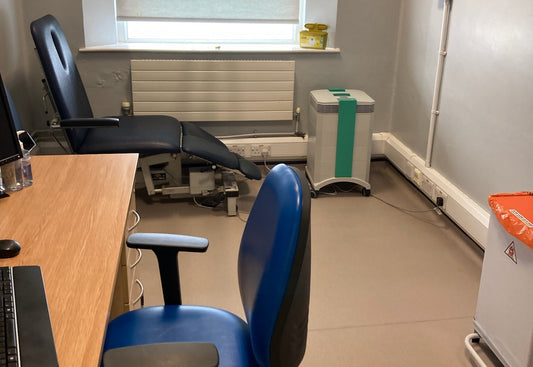Cystic fibrosis is one of the most common genetic diseases, affecting around 9,000 people in the UK. The condition affects all the organs of the body, particularly the lungs and the digestive system. The lungs tend to become congested with thick, sticky mucus which is particularly prone to infection. Mycobacterium abscessus infection control is important to protect the lungs.
Mycobacterium Abscessus
One such infection, which is becoming more common worldwide among those with cystic fibrosis, is Mycobacterium abscessus, a bacterium found in soil and water which is distantly related to Mycobacterium tuberculosis, which causes tuberculosis. Mycobacterium abscessus causes progressive damage to the lung tissue and is very hard to treat once it has taken hold in a cystic fibrosis patient. A new study published in The Lancet from researchers at Papworth Hospital, the University of Cambridge and The Wellcome Trust Sanger Institute sheds new light on mycobacterium abscessus infection control, and how mycobacterium abscessus is transmitted which could change the way cystic fibrosis patients are treated in hospital in order to improve airborne infection control.
The scientists applied advanced DNA sequencing to 170 isolates of mycobacterium abscessus taken from cystic fibrosis patients over a period of five years. This approach produced the genome (entire DNA content in sequence order) of each isolate which, in turn, showed how they were related to one another. The conclusion was that the pathogen is capable of being passed from one patient to another. Previously, it had not been realised that this could happen and it was thought that the patient contracted the infection directly through contact with contaminated soil or water. The fact that the Mycobacterium abscessus infection is being passed between patients, despite infection control measures in the hospital, means that these control measures must now be intensified.
The doctors at Papworth Hospital think that the Mycobacterium abscessus bacterium may become aerosolised when a patient coughs, tiny infected droplets enter the air so they can be inhaled by another person or settle on surfaces and are then picked up again through touch. To try to combat Mycobacterium abscessus infections, Papworth Hospital now treats all patients in negative pressure hospital isolation room and isolates those who have Mycobacterium abscessus from other patients.
Creating a negative pressure environment in a room to control Mycobacterium abscessus infections means having more air being removed and filtered from the room (typically about 10 per cent more) than enters it. Air flows from regions of high pressure to regions of low pressure, so air enters the room from outside but does not flow back in the other direction from the room to the outside (eg back into the corridor) and thus prevents the Mycobacterium abscessus infection to spread. A negative pressure environment can be achieved via a ventilation and filtration system set up to have an exhaust fan and filter in operation so that air is cleaned and removed from the room (think of the fan exhaust that removes moisture and odours from a bathroom as a simple example of negative pressure).
In a negative pressure hospital room, a small amount of air enters the room from a gap at the bottom of the door, and then the extractor fan ensures that exhaust air leaves the room to the external surroundings via a pipe. A smoke test can be carried out to ensure that the ventilation system is functioning correctly. A smoke tube is placed near the bottom of the door outside the room that is under negative pressure. It is squeezed gently to introduce a small amount of smoke and this should visibly be drawn into the room under the door. If the negative pressure system is not working, the smoke remains stationary or is blown back. The presence of cracks in walls, around light or other fixtures, or around windows impairs negative pressure, so a properly sealed room is an important part of the negative pressure set up.
Negative pressure rooms keep airborne infection such as Mycobacterium abscessus inside the room and contained. They are commonly used to prevent the spread of TB, bird flu (H5N1) and other highly infectious diseases. On the other side of the coin, a positive pressure environment is a room where air flows from the room to the outside, rather than the other way round. These are used in hospitals to protect the patient from their surroundings – for instance, where immunocompromised patients such as those with HIV/AIDs or undergoing bone marrow transplantation might be at risk from aspergillosis (a common fungal infection).
An excellent way of achieving effective negative or positive pressure environments for Mycobacterium abscessus infection control at will in the healthcare setting is to invest in portable air purification units which can be moved to whichever rooms happen to be occupied by patients who are infected by pathogens such as Mycobacterium abscessus or those who are at risk of infection because of compromised immunity.
Systems such as the IQAir Cleanroom Series should form the centrepiece of such a solution. The Series comprises a range of self-contained and portable High-Efficiency Particulate Air (HEPA) filtration systems which can filter the air by recirculation or by creating true negative or positive pressure environments with dedicated IQAir ducting adaptors. The air purification system is connected to the appropriate adaptor in order to create the required pressure differential between adjacent areas. The three models (Cleanroom 100, 250 and H13) are designed for removal of solid and liquid airborne particles and aerosols. Their main application is in airborne infection control in healthcare settings and for control of particulate matter in cleanroom settings. The IQAir Cleanroom 250 is also capable of removing gaseous contamination.
Each model in the Cleanroom Series has an antimicrobial pre-filter which prolongs the life of the main filter. This is an antimicrobial HyperHEPA filter which has guaranteed the efficiency of greater than or equal to 99.97 per cent removal of particles of size 0.3 microns or more. Most bacterial pathogens, including Mycobacterium abscessus have a size in the 1-5 micron range. The IQAir Cleanroom series is being used in a variety of healthcare settings including protective isolation rooms, TB isolation and anterooms, oncology wards, operating rooms and intensive care units.
Contact one of our experts to find out more and discover how you can improve patient care in your hospital:
Tel: 020 3176 0524 or Email: Info@CommercialAirFiltration.co.uk.




